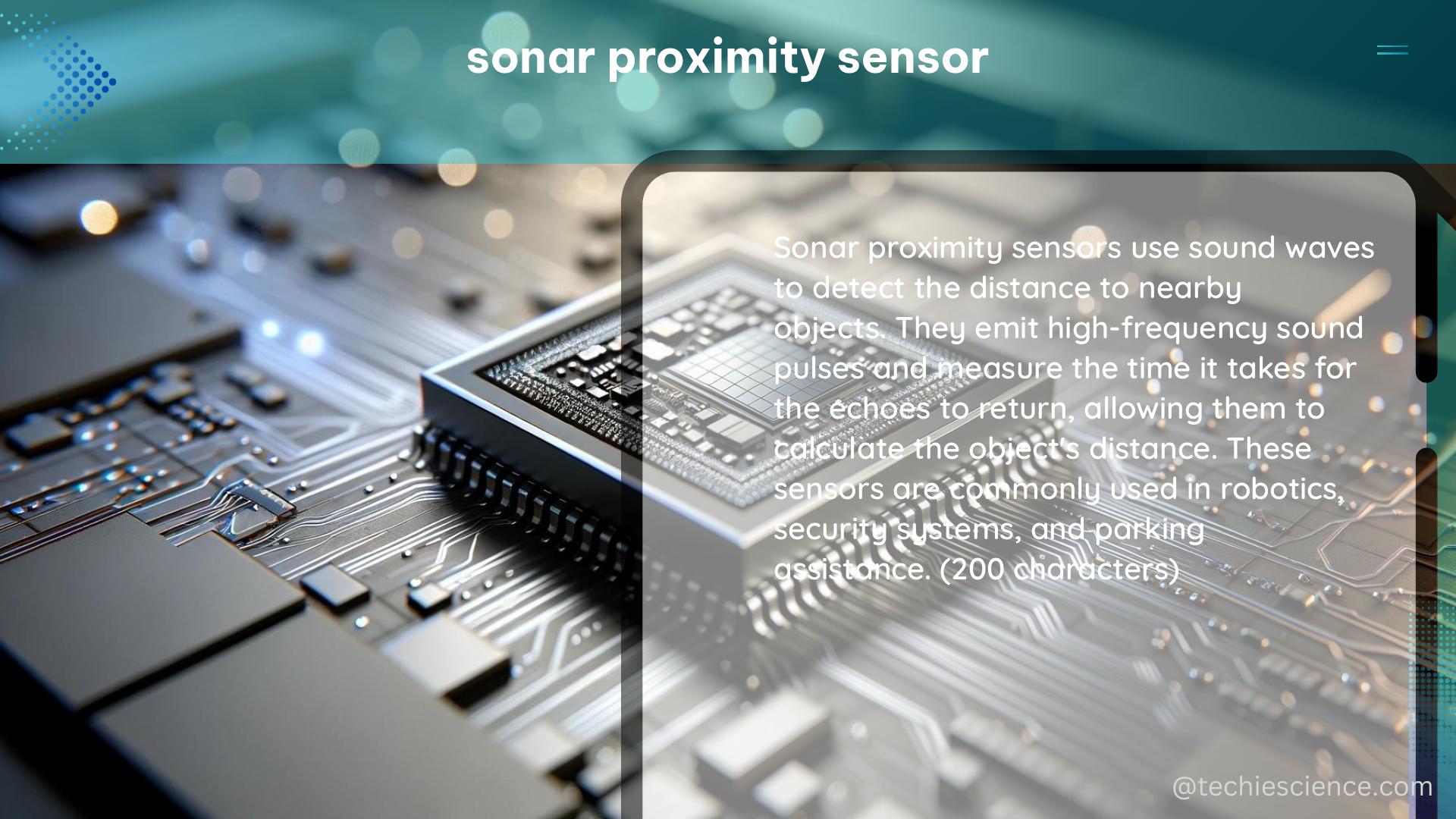The sonar proximity sensor, exemplified by the popular HC-SR04 module, is a versatile and widely-used device for distance measurement and obstacle detection in a variety of applications. With a measurable range of 2 cm to 400 cm and a precision of around 2.5%, these sensors offer a reliable and cost-effective solution for DIY projects, robotics, and industrial automation.
Understanding the Fundamentals of Sonar Proximity Sensors
Sonar proximity sensors, such as the HC-SR04, operate on the principle of ultrasonic wave propagation. The sensor emits a high-frequency sound wave (typically 40 kHz) and measures the time it takes for the wave to bounce back after hitting an obstacle. By calculating the time-of-flight (ToF) of the sound wave, the sensor can determine the distance to the object.
The technical specifications of the HC-SR04 sensor include:
- Measurable range: 2 cm to 400 cm
- Precision: Around 2.5%
- Sound frequency: 40 kHz
- Angle of detection: 15 degrees
- Supply voltage: 5V to 20V
It’s important to note that the sensor’s raw data is typically provided in microseconds, which must be converted to centimeters or inches for practical use. This conversion can be easily accomplished using the following formula:
Distance (cm) = (Time (μs) × 0.034) / 2
or
Distance (inches) = (Time (μs) × 0.013) / 2
Factors Affecting Sonar Proximity Sensor Accuracy

While the HC-SR04 sensor offers a relatively high level of precision, there are several factors that can impact the accuracy of distance measurements:
-
Measurement Error Distribution: The measurement error of the HC-SR04 does not follow a Gaussian (normal) distribution, which can affect the choice of data processing methods and statistical analysis techniques.
-
Environmental Conditions: Factors such as temperature, humidity, and air pressure can influence the speed of sound, which is a critical parameter in the distance calculation.
-
Surface Characteristics: The reflectivity and angle of the target object can affect the strength and direction of the reflected ultrasonic wave, leading to measurement errors.
-
Interference: Nearby objects, electromagnetic fields, or other ultrasonic sources can interfere with the sensor’s operation, causing inaccurate readings.
Improving Sonar Proximity Sensor Accuracy
To enhance the accuracy of distance measurements using the HC-SR04 sensor, consider the following techniques:
-
Multiple Readings: Take multiple readings and apply appropriate filtering techniques, such as using the mode or median instead of the average, to reduce the impact of outliers and improve the overall reliability of the measurements.
-
Custom Estimation Algorithms: Develop custom estimation algorithms that take into account the distribution of the measurement error, allowing for more accurate distance calculations.
-
Environmental Compensation: Implement algorithms that adjust the distance calculations based on environmental factors, such as temperature and humidity, to compensate for changes in the speed of sound.
-
Sensor Fusion: Combine the sonar proximity sensor with other types of sensors, such as infrared or laser rangefinders, to create a more robust and accurate distance measurement system.
-
Sensor Calibration: Regularly calibrate the sensor to ensure that it is providing accurate and consistent measurements, especially in applications where precise distance tracking is critical.
Advanced Applications of Sonar Proximity Sensors
Beyond basic distance measurement and obstacle detection, sonar proximity sensors can be employed in a wide range of advanced applications, including:
-
Robotic Navigation: Sonar sensors can be used in autonomous robots and drones to map their surroundings, avoid obstacles, and navigate through complex environments.
-
Gesture Recognition: The directional sensitivity of sonar sensors can be leveraged for gesture-based control systems, enabling intuitive human-machine interactions.
-
Liquid Level Monitoring: Sonar sensors can be used to measure the level of liquids in tanks, silos, or other containers, providing valuable data for industrial process control and inventory management.
-
Non-Contact Measurement: Sonar sensors can be used to measure the dimensions, shape, or position of objects without physical contact, making them suitable for applications where traditional contact-based methods are impractical or undesirable.
-
Underwater Sensing: Specialized waterproof sonar sensors can be used for underwater applications, such as bathymetric mapping, submarine detection, and marine life monitoring.
Conclusion
The sonar proximity sensor, exemplified by the HC-SR04 module, is a versatile and powerful tool for distance measurement and obstacle detection. By understanding the fundamental principles, technical specifications, and factors affecting sensor accuracy, you can effectively leverage these sensors in a wide range of DIY projects, robotics applications, and industrial automation solutions. With the right techniques and strategies, you can unlock the full potential of sonar proximity sensors and push the boundaries of what’s possible.
References
- HC-SR04: tests on accuracy, precision and resolution of ultrasonic measurement – Arduino Forum: https://forum.arduino.cc/t/hc-sr04-tests-on-accuracy-precision-and-resolution-of-ultrasonic-measurement/236505
- Distance Sensing With the Micro:bit and Sonar (HC-SR04 Module) – Instructables: https://www.instructables.com/Distance-Sensing-With-the-Microbit-and-Sonar-HC-SR04-Module/
- Measuring within a range ultrasonic sensors – Arduino Forum: https://forum.arduino.cc/t/measuring-within-a-range-ultrasonic-sensors/657501
- Ultrasonic Sensor HC-SR04 and Arduino Tutorial – Random Nerd Tutorials: https://randomnerdtutorials.com/complete-guide-for-ultrasonic-sensor-hc-sr04/
- Ultrasonic Sensor Accuracy and Precision – Maxbotix: https://www.maxbotix.com/articles/ultrasonic-sensor-accuracy-and-precision.htm

The lambdageeks.com Core SME Team is a group of experienced subject matter experts from diverse scientific and technical fields including Physics, Chemistry, Technology,Electronics & Electrical Engineering, Automotive, Mechanical Engineering. Our team collaborates to create high-quality, well-researched articles on a wide range of science and technology topics for the lambdageeks.com website.
All Our Senior SME are having more than 7 Years of experience in the respective fields . They are either Working Industry Professionals or assocaited With different Universities. Refer Our Authors Page to get to know About our Core SMEs.